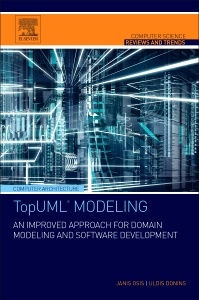Description
Topological UML Modeling
An Improved Approach for Domain Modeling and Software Development
Computer Science Reviews and Trends Series
Authors: Osis Janis, Donins Uldis
Language: English
Subjects for Topological UML Modeling:
Keywords
Activity diagram; Behavior analysis; Benefits and limitations of UML modeling driven approaches; Communication diagram; Component diagram; Components; Computation independent viewpoint; Creating and extending metamodels; Deployment diagram; Formal behavior analysis and design; Formal structure analysis and design; Functional requirements; Functioning characteristics; Interaction overview diagram; Interfaces; Logical layout; MOF; Metamodel definition; Metamodeling; Modeling formalization; Nodes; Nonfunctional requirements; Object diagram; Object state change; Object state transition; Package diagram; Packages; Platform independent viewpoint; Problem domain analysis; Relationships; Seams between viewpoints; Sequence diagram; Software modeling methods and approaches; Software system specification; State diagram; Structure analysis; TFM; Top-down design; TopUML modeling; Topological class diagram; Topological functioning model; Topological functioning model (TFM); Topological space; Topological unified modeling language; Topological use case diagram; UML; UML application; UML extension; UML metamodel; UML profiles
41.68 €
In Print (Delivery period: 14 days).
Add to cartSupport: Print on demand
Description
/li>Contents
/li>Biography
/li>Comment
/li>
Topological UML Modeling: An Improved Approach for Domain Modeling and Software Development presents a specification for Topological UML® that combines the formalism of the Topological Functioning Model (TFM) mathematical topology with a specified software analysis and design method. The analysis of problem domain and design of desired solutions within software development processes has a major impact on the achieved result ? developed software.
While there are many tools and different techniques to create detailed specifications of the solution, the proper analysis of problem domain functioning is ignored or covered insufficiently.
The design of object-oriented software has been led for many years by the Unified Modeling Language (UML®), an approved industry standard modeling notation for visualizing, specifying, constructing, and documenting the artifacts of a software-intensive system, and this comprehensive book shines new light on the many advances in the field.
1. Unified Modeling Language – a Standard for Designing a Software2. Software Designing with UML Modeling Driven Approaches3. Adjusting Unified Modeling Language4. Topological Unified Modeling Language5. Topological UML Modeling6. Problem Domain Functioning Analysis7. Behavior Analysis and Design8. Structure Analysis and Design9. Object State Change and Transition Analysis10. Logical Layout of Software Design11. Components and Deployment Design
Janis Osis is Professor at Faculty of Computer Science and Information Technology at Riga Technical University, Latvia. He graduated Faculty of Mechanics of the Latvian State University with summa cum laude and received diploma of Electrical engineering in electrical systems. After doctoral studies in Sankt Petersburg Electrical University, Russia he obtained his Dr.sc.ing. Degree from Kaunas Technological University, Lithuania. After defense of habilitation thesis titled “Diagnostics of Complex systems he received his Dr.habil.sc.ing. Degree in system analysis from Latvian Academy of Sciences.
He started his career as assistant professor at Mechanical faculty of the Latvian State University and followed it at Riga Technical University as docent and founding Dean of Faculty of Automatics and Computer Engineering. In addition J. Osis served as chairman of departments and habilitation committees at Riga Technical University.
He was visiting researcher at Department of Electrical Engineering and Computer Science, University of California, Berkeley, USA and Dipartimento di Matematica Pura ed Applicata, Universita’ degli Studi di Padova, Italia.
Since 1965 his research interests are topological modeling of complex systems with applications in technical and medical diagnostics. Recent fields of interest are object-oriented system development, formal methods of software engineering, model driven software development (including the OMG standard of MDA) by means of topological functioning model support. His list of publications contains more than 250 scientific papers and 16 books including: J. Osis, E. Asnina. Model-Driven Domain Analysis and Software Development: Architectures and Functions. IGI Global, Hershey - New York, 2011, 487 p.
J. Osis is a member of the International Editorial Board “Journal Automatic Control and Computer Sciences, Allerton Press, Inc. Riga - New York and of the International Software Engineering Journal e-Informatika
- Presents an approach to formally define, analyze, and verify functionality of existing processes and desired processes to track incomplete or incorrect functional requirements
- Describes the path from functional and nonfunctional requirements specification to software design with step-by-step creation and transformation of diagrams and models with very early capturing of security requirements for software systems.
- Defines all modeling constructs as extensions to UML®, thus creating a new UML® profile which can be implemented in existing UML® modeling tools and toolsets
These books may interest you

Guide to Applying the UML 52.74 €

Software Engineering with UML 53.83 €

Software Engineering with UML 148.11 €

